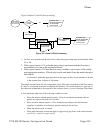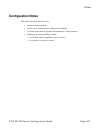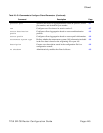
Cflowd
7750 SR OS Router Configuration Guide Page 441
Within the active flow cache, the following characteristics are used to identify an individual flow:
• Ingress interface
• Source IP address
• Destination IP address
• Source transport port number
• Destination transport port number
• IP protocol type
• IP TOS byte
The 7750 SR OS implementation allows you to enable cflowd either at the interface level or as an
action to a filter. By enabling cflowd at the interface level, all packets forwarded by the interface
are subject to cflowd analysis. By setting cflowd as an action in a filter, only packets matching the
specified filter are subject to cflowd analysis. This provides the network operator greater flexibility
in the types of flows that are captured.
Collectors
A collector defines the data flow for exporting sampled data from the cache. A maximum of 5
collectors can be configured. Each collector is identified by a unique IP address and UDP port
value. The parameters within a collector configuration can be modified or the defaults retained.
The
autonomous-system-type command defines whether the autonomous system information
to be included in the flow data is based on the originating AS or external peer AS of the flow.
Aggregation
V8 aggregation allows for flow data to be aggregated into larger, less granular flows. Use
aggregation commands to specify the type of data to be collected. Only flows that match the
specified criteria are sent.
The following aggregation schemes are supported:
• AS matrix — Flows are aggregated based on source and destination AS and ingress and
egress interface.
• Protocol-port — Flows are aggregated based on the IP protocol, source port number, and
destination port number.
• Source prefix — Flows are aggregated based on source prefix and mask, source AS, and
ingress interface.
• Destination prefix — Flows are aggregated based on destination prefix and mask,
destination AS, and egress interface.


















